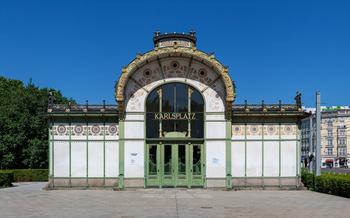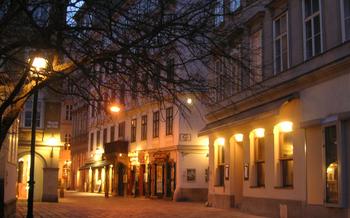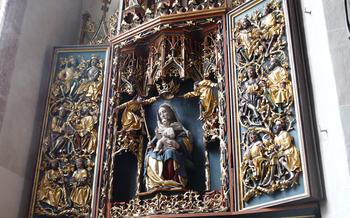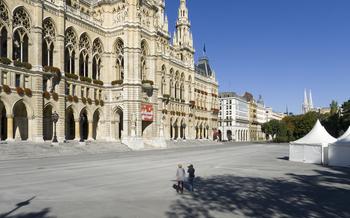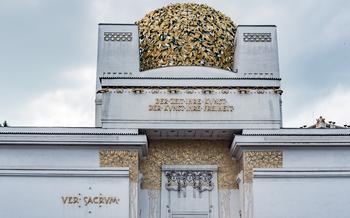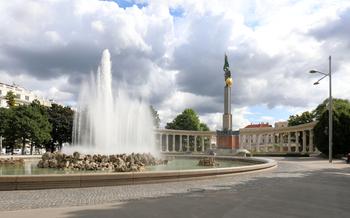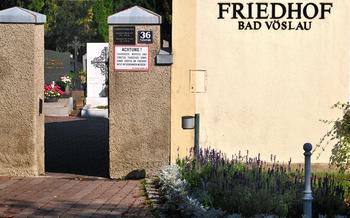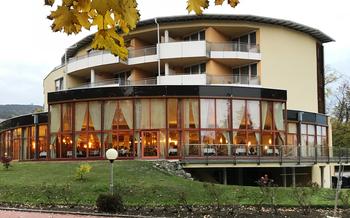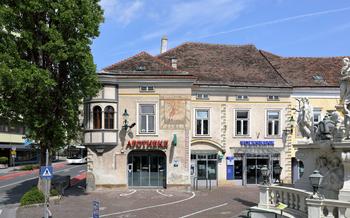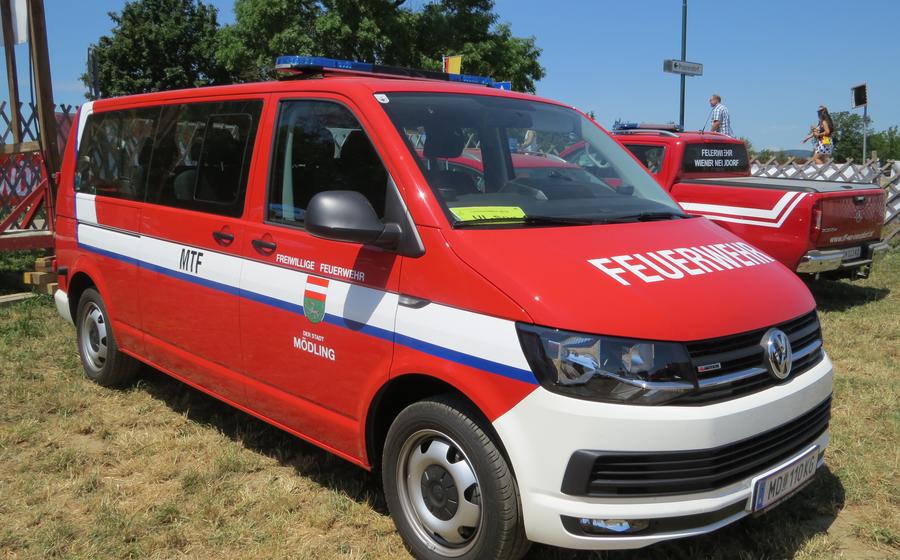
Otto Wagner Pavillon Karlsplatz
- History of the Otto Wagner Pavillon Karlsplatz
- Location and Accessibility
- Architecture and Design
- Original Purpose and Current Use
- Admission and Hours of Operation
- Exhibitions and Events
- Interior and Highlights
- Otto Wagner's Legacy
- Historical Significance
- Surrounding Area
- Photography and Social Media
- Accessibility for Visitors with Disabilities
- Guided Tours
- Combine with Other Attractions
- Insider Tip: Unveiling the Hidden Charm
History of the Otto Wagner Pavillon Karlsplatz
In the heart of Vienna's vibrant Karlsplatz, the Otto Wagner Pavillon Karlsplatz stands as a testament to the city's rich architectural heritage. Commissioned in 1897 by the Vienna Municipal Council as part of the Stadtbahn project, a revolutionary urban railway system, the pavilion was designed by renowned architect Otto Wagner, a pioneer of Viennese Modernism.
Wagner's design for the pavilion reflected his progressive approach to architecture, blending Art Nouveau aesthetics with functionalist principles. The pavilion's striking exterior, characterized by its metallic structure, glass panels, and intricate ornamentation, set a new standard for public architecture in Vienna. Its innovative use of materials and construction techniques, such as prefabricated elements and exposed steel beams, showcased Wagner's commitment to modern engineering and design.
Wagner's vision extended beyond the pavilion's exterior. The interior spaces, adorned with colorful mosaics, murals, and sculptures, created a harmonious and visually captivating environment. The pavilion's distinctive design and artistic features made it a symbol of Vienna's transformation into a modern metropolis at the turn of the 20th century.
Location and Accessibility
The Otto Wagner Pavillon Karlsplatz is conveniently situated in the heart of Vienna, at Karlsplatz, a bustling square that serves as a major transportation hub. The exact address is Karlsplatz 5, 1040 Wien. It is easily accessible by various public transportation options, making it a convenient destination for both locals and tourists.
To reach the pavilion by metro, take the U1, U2, or U4 lines and alight at Karlsplatz station. From there, follow the signs to the pavilion, which is just a short walk away. Alternatively, you can take tram lines 1, 2, 62, or 71, which also stop at Karlsplatz.
The pavilion's central location places it within easy reach of numerous other attractions in Vienna. The stunning Karlskirche, a baroque masterpiece, is just a stone's throw away. The Belvedere Museum, housing an impressive collection of Austrian art, is also nearby. Additionally, the Naschmarkt, a vibrant market offering a diverse array of culinary delights, is just a short walk from the pavilion.
Architecture and Design
The Otto Wagner Pavillon Karlsplatz stands out for its unique and innovative design, reflecting Wagner's commitment to modern architecture and his belief in the integration of art and technology. The pavilion features a striking metal framework in a combination of steel and cast iron, showcasing Wagner's mastery of these materials. The structure is supported by slender columns, giving it a sense of lightness and transparency.
Wagner's attention to detail is evident in the intricate ornamentation and decorative elements that adorn the pavilion. The building's façade is adorned with colorful glazed ceramic tiles, mosaics, and metalwork, creating a vibrant and visually captivating display. The interior of the pavilion features a vaulted ceiling adorned with beautiful murals and paintings by renowned Austrian artists, including Koloman Moser and Alfred Roller, further enhancing its artistic significance.
Original Purpose and Current Use
The Otto Wagner Pavillon Karlsplatz, initially constructed as part of the Stadtbahn railway network, played a crucial role in Vienna's urban transportation system. Designed as an entrance to the Stadtbahn station located beneath Karlsplatz, the pavilion served as a gateway for passengers to access the underground railway lines.
With the discontinuation of the Stadtbahn in 1989, the pavilion's original function came to an end. Recognizing its architectural significance and cultural value, the City of Vienna decided to repurpose the structure into an exhibition space. Following extensive renovations, the pavilion reopened its doors in 1994 as a venue dedicated to hosting a variety of exhibitions, events, and cultural programs.
Today, the Otto Wagner Pavillon Karlsplatz serves as a vibrant platform for showcasing contemporary art and design. The pavilion's flexible exhibition space has been utilized for diverse exhibitions, ranging from solo presentations by established artists to group shows featuring emerging talents. Additionally, the venue has hosted cultural events, lectures, and workshops, creating a dynamic space for artistic expression and cultural exchange.
The pavilion's transformation from a transportation hub to an exhibition space exemplifies Vienna's commitment to preserving its architectural heritage while embracing contemporary cultural trends. It stands as a testament to the city's rich history and its dedication to promoting art and culture.
Admission and Hours of Operation
Admission to the Otto Wagner Pavillon Karlsplatz is free of charge, making it accessible to visitors from all walks of life. The pavilion's regular hours of operation are from 10 am to 6 pm, Tuesday through Sunday. However, it is essential to note that these hours may vary during public holidays or special events.
For a more immersive experience, guided tours are available upon request and offer a deeper dive into the history, architecture, and significance of the pavilion. These tours typically require reservations and may incur a small fee.
To stay updated on the latest exhibitions, events, and any changes in operating hours, it is advisable to check the official website of the Otto Wagner Pavillon Karlsplatz or contact the venue directly.
Exhibitions and Events
The Otto Wagner Pavillon Karlsplatz serves as a versatile exhibition space, hosting a diverse range of cultural events throughout the year. These exhibitions primarily focus on architecture, urban planning, and the legacy of Otto Wagner himself. Past exhibitions have explored topics such as Wagner's influence on Viennese architecture, the development of the Stadtbahn, and the history of the pavilion itself. The pavilion has also hosted temporary exhibitions showcasing the works of contemporary architects and designers, as well as historical artifacts related to Viennese art and culture.
In addition to exhibitions, the pavilion regularly hosts events such as lectures, workshops, and symposia. These events provide a platform for experts and enthusiasts to discuss various aspects of architecture, urbanism, and design. The pavilion's intimate setting and central location make it an ideal venue for these types of gatherings.
Upcoming exhibitions and events at the Otto Wagner Pavillon Karlsplatz can be found on the official website of the Architekturzentrum Wien, which manages the pavilion. Visitors are encouraged to check the website regularly for the latest information on upcoming events and to plan their visit accordingly.
Interior and Highlights
The interior of the Otto Wagner Pavillon Karlsplatz is a testament to Wagner's meticulous attention to detail and his commitment to creating a harmonious and functional space. The pavilion's central feature is its large, open-plan exhibition hall, which is bathed in natural light thanks to the floor-to-ceiling windows that line the walls. The hall's minimalist design, with its white walls and polished stone floors, provides a neutral backdrop for the diverse exhibitions that are held here.
One of the highlights of the pavilion's interior is the intricate metalwork that adorns the walls and ceiling. Wagner's use of metal, a relatively new material at the time, was both innovative and controversial. The metalwork features a variety of motifs, including geometric patterns, floral designs, and human figures. These decorative elements add a touch of elegance and sophistication to the pavilion's interior.
Another notable feature of the pavilion's interior is the series of murals that were created by the Austrian artist Koloman Moser. These murals depict scenes from classical mythology and were intended to complement the pavilion's overall design. The murals are a beautiful example of the collaboration between Wagner and Moser, two of the most important figures in the Viennese Secession movement.
Overall, the interior of the Otto Wagner Pavillon Karlsplatz is a stunning example of Wagner's architectural genius. The pavilion's combination of functionality, beauty, and innovation make it a must-see for anyone interested in architecture, design, or Viennese history.
Otto Wagner's Legacy
The Otto Wagner Pavillon Karlsplatz stands as a testament to the visionary genius of Otto Wagner, a pioneer of Viennese architecture and a leading figure in the Art Nouveau movement. Wagner's contributions to the city of Vienna are immeasurable, and the pavilion serves as a tangible representation of his architectural prowess.
Wagner's legacy extends far beyond the pavilion's walls, leaving an indelible mark on the urban landscape of Vienna. His innovative designs and unwavering commitment to functionality and aesthetics transformed the city, shaping its architectural identity and earning him the title of "Master of Modernism."
Among Wagner's most notable works in Vienna are the Majolikahaus, a stunning apartment building adorned with colorful ceramic tiles, and the Postal Savings Bank, an architectural masterpiece that combines Art Nouveau elements with classical influences. These structures, along with the Otto Wagner Pavillon Karlsplatz, stand as testaments to Wagner's enduring legacy and his profound impact on the city's architectural heritage.
Wagner's influence extended beyond Vienna, reaching across Europe and beyond. His innovative ideas and architectural principles were widely adopted, inspiring a generation of architects and shaping the course of modern architecture. His legacy lives on in the numerous buildings, designs, and theories he left behind, continuing to influence and inspire architects and urban planners to this day.
Historical Significance
The Otto Wagner Pavillon Karlsplatz holds a significant place in Vienna's urban development and cultural history. Constructed as part of the Stadtbahn project, the pavilion played a crucial role in the city's transportation infrastructure. It served as a hub for passengers transferring between the Stadtbahn and other modes of transport, such as trams and horse-drawn carriages. The pavilion's unique design and prominent location made it a landmark in its own right, becoming a symbol of Vienna's embrace of modernity and progress.
Over the years, the pavilion has undergone several renovations and changes in use. It was initially intended to be a temporary structure, but its architectural significance led to its preservation and adaptation for various purposes. In the 1950s, the pavilion was transformed into an exhibition space, hosting a variety of art exhibitions, cultural events, and conferences. This transformation allowed the pavilion to continue serving the public and contributing to Vienna's cultural landscape.
The Otto Wagner Pavillon Karlsplatz has received numerous accolades and recognition for its architectural value. It is considered one of the finest examples of Wagner's work and a masterpiece of Viennese Art Nouveau architecture. In 1972, the pavilion was designated as a protected historical monument, ensuring its preservation for future generations. Its iconic status and historical significance make it a must-visit attraction for anyone interested in Viennese architecture and urban history.
Surrounding Area
The Otto Wagner Pavillon Karlsplatz is situated in a vibrant and culturally rich neighborhood, offering visitors a plethora of attractions and experiences to enhance their visit. Just a short walk away lies the renowned Naschmarkt, one of Vienna's oldest and most famous markets. Here, you can indulge in a culinary journey, savoring the diverse flavors of local and international cuisines, from fresh produce to mouthwatering street food. Explore the maze-like alleys, discover hidden gems, and soak up the lively atmosphere that permeates this bustling marketplace.
In the immediate vicinity of the pavilion, you will find the Secession Building, a masterpiece of Viennese Art Nouveau architecture. This iconic landmark houses a collection of stunning paintings, sculptures, and decorative arts, showcasing the works of Gustav Klimt, Egon Schiele, and other prominent artists of the era. Step inside and immerse yourself in the vibrant colors and intricate symbolism that characterize this artistic movement.
For those seeking a tranquil retreat, the Resselpark offers a serene oasis just steps away from the pavilion. Take a leisurely stroll amidst lush greenery, admire the ornate fountain, and unwind in the peaceful ambiance of this charming park. It's the perfect place to escape the hustle and bustle of the city and find a moment of tranquility.
Art enthusiasts will delight in exploring the MuseumsQuartier, a vibrant cultural complex located a short walk from the pavilion. Here, you can visit a cluster of museums, including the Leopold Museum, the MUMOK, and the Kunsthalle Wien, each showcasing a diverse range of modern and contemporary art exhibitions. Immerse yourself in the world of cutting-edge creativity and discover new perspectives on the art of our time.
Photography and Social Media
The Otto Wagner Pavillon Karlsplatz is a visual delight, offering ample opportunities for photography enthusiasts and social media-savvy travelers. With its distinctive green dome, intricate metalwork, and surrounding greenery, the pavilion makes for a stunning backdrop for your Instagram feed.
Capture the iconic exterior of the pavilion, showcasing its unique architectural features and the surrounding cityscape. Experiment with different angles and perspectives to create visually striking compositions. The pavilion's symmetry and curved lines lend themselves well to creative photography.
Inside the pavilion, discover a treasure trove of photogenic details. From the intricate mosaics and murals to the elegant chandeliers and decorative elements, there's no shortage of Instagram-worthy moments. Don't miss the stunning stained-glass windows that bathe the interior in a kaleidoscope of colors.
When sharing your photos, use relevant hashtags such as #OttoWagnerPavillon, #ViennaArchitecture, and #ArtNouveau to connect with other travelers and architecture enthusiasts. Share your experiences and insights about the pavilion, and encourage your followers to explore this hidden gem in Vienna.
Accessibility for Visitors with Disabilities
The Otto Wagner Pavillon Karlsplatz is committed to providing an accessible and inclusive environment for all visitors. The pavilion features a number of accessibility features to ensure that visitors with disabilities can easily navigate and enjoy the space.
The entrance to the pavilion is wheelchair accessible, and there is a designated wheelchair parking area nearby. Inside the pavilion, there are ramps and elevators that allow visitors to access all levels of the building. The exhibition spaces are also wheelchair accessible, and there are accessible restrooms available.
In addition to these physical features, the pavilion also offers a variety of services for visitors with disabilities. Assistive listening devices and closed captioning are available for events and exhibitions, and staff members are trained to provide assistance to visitors with disabilities.
The Otto Wagner Pavillon Karlsplatz is a welcoming and inclusive space for all visitors, and it is committed to providing a positive and enjoyable experience for everyone.
Guided Tours
The Otto Wagner Pavillon Karlsplatz offers guided tours that provide a deeper insight into its history, architecture, and significance. These tours are conducted by knowledgeable guides who share fascinating stories and anecdotes about the pavilion and its creator, Otto Wagner. Visitors can choose from various tour options, including regular guided tours, thematic tours focusing on specific aspects of the pavilion, and private tours tailored to individual interests.
Booking a guided tour is highly recommended for those who want to make the most of their visit. Guided tours allow visitors to explore the pavilion's interior spaces, including the exhibition hall, the mezzanine, and the roof terrace, while learning about the building's unique features, design principles, and cultural influences. Guides also provide historical context and explain the role of Otto Wagner in the development of Viennese architecture.
To book a guided tour, visitors can either reserve online in advance or inquire at the pavilion's information desk. Fees for guided tours vary depending on the type of tour and the number of participants. It is advisable to book early, especially for popular tour times or during peak tourist season, to avoid disappointment.
Combine with Other Attractions
The Otto Wagner Pavillon Karlsplatz is situated in a vibrant neighborhood teeming with attractions that cater to diverse interests. To fully immerse yourself in the city's rich heritage, consider combining your visit to the pavilion with other notable landmarks and experiences nearby.
Start by exploring the surrounding Karlsplatz, a bustling square that harbors architectural marvels, including the Karlskirche, a baroque masterpiece known for its striking dome. Stroll along the opulent Ringstrasse boulevard, lined with grand buildings like the State Opera House and the Kunsthistorisches Museum, housing an impressive collection of art from the Habsburg era.
For a dose of contemporary art, head to the nearby Belvedere Museum, showcasing works by Austrian masters like Gustav Klimt and Egon Schiele. Immerse yourself in the vibrant art scene by visiting galleries, studios, and cultural spaces scattered throughout the district.
To escape the urban buzz, seek refuge in the lush greenery of the Stadtpark, located just a short walk from the pavilion. This tranquil oasis offers serene paths, charming sculptures, and the opportunity to witness a concert at the Kursalon, a magnificent concert hall within the park.
Foodies will delight in the culinary offerings of the Naschmarkt, Vienna's largest and oldest market, situated a short distance from the pavilion. This vibrant market boasts an array of international cuisines, fresh produce, and specialty food shops, providing a feast for the senses.
Insider Tip: Unveiling the Hidden Charm
To fully appreciate the Otto Wagner Pavillon Karlsplatz, plan your visit wisely. Avoid the peak tourist season, typically from June to August, when crowds can diminish the serene ambiance of the pavilion. Instead, aim for the shoulder months of May and September, or even better, the tranquility of the off-season from October to April. During these periods, you'll not only encounter fewer visitors but also stumble upon unique events and exhibitions tailored for the local community.
While in the area, take the opportunity to explore the surrounding neighborhood, rich in hidden gems. Just a short walk away, immerse yourself in the vibrant Naschmarkt, Vienna's largest and most popular market. Here, you'll find an eclectic mix of local delicacies, international flavors, and vibrant street art. For a touch of tranquility, stroll through the idyllic gardens of the Palais Auersperg, a hidden oasis nestled amidst the bustling city.
And if you're a fan of Otto Wagner's work, don't miss the Majolikahaus, another architectural masterpiece located just a few minutes away. Adorned with intricate ceramic tiles and mosaics, this residential building is a testament to Wagner's innovative and artistic vision.
As you wander through the neighborhood, be sure to engage with the locals. They'll gladly share stories, anecdotes, and personal experiences related to the Otto Wagner Pavillon Karlsplatz, providing a glimpse into the cultural significance of this architectural gem.
